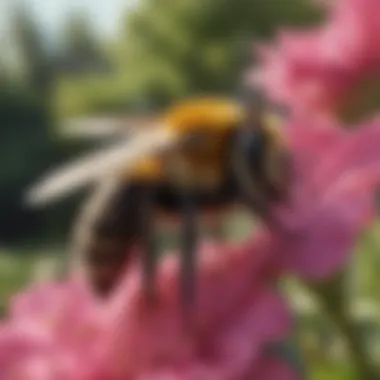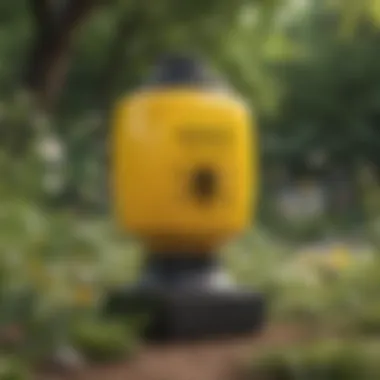Effective Bumble Bee Repellent Strategies for Your Yard


Intro
Bumble bees play a crucial role in pollination. Their presence in residential yards can enhance the biodiversity of gardens. However, some homeowners may find their buzzing presence troublesome, especially during outdoor gatherings. This guide addresses effective methods for managing bumble bee populations while respecting their ecological importance. It is essential to balance personal comfort with the need to preserve these vital insects.
The following sections will explore practical strategies for bumble bee repellent, including commercial solutions and DIY techniques. Additionally, we will consider how to maintain a harmonious environment that supports the benefits that bumble bees provide. Understanding these aspects will equip homeowners with the knowledge needed to take informed action without causing harm to these essential pollinators.
Understanding Bumble Bees
Understanding bumble bees is essential to creating a balanced approach towards managing their presence in residential spaces. Bumble bees play a crucial role in the ecosystem, primarily through their pollination activities. As homeowners, being informed about these insects can shape how we interact with them and influence our gardening practices. Emphasizing knowledge about bumble bees fosters a more harmonious relationship, ensuring that both human needs and environmental health can be prioritized.
Biology and Behavior
Biology and behavior encompass the physical traits and social characteristics of bumble bees. These elements are significant for understanding their actions in your yard and developing effective management techniques.
Physical characteristics of bumble bees
Bumble bees are recognizable by their large, fuzzy bodies, which come in a variety of colors. Typically, they have black and yellow stripes, although some species also exhibit white and orange markings. Their size matters; bumble bees are generally larger compared to other bees. This physical trait aids their flight and efficiency in pollination.
The advantage of these formidable bodies allows them to forage in cooler weather, making them active earlier in the spring than other pollinators. However, their size can be intimidating for some people, leading to safety concerns that may prompt the use of repellent methods if bumble bees are too close. Understanding these characteristics can help differentiate between the various bee species present in your yard, influencing decisions on whether to manage or coexist with them.
Social structure and colony dynamics
Bumble bees are social insects that live in colonies. These colonies can house dozens to several hundred individuals. The primary structure consists of a queen, worker bees, and drones. During the spring, the queen emerges from hibernation to start a new colony. This social structure allows for efficient communication and division of labor among the bees.
Recognizing this dynamic is beneficial as it informs homeowners about the timing of bumble bee activity. Understanding when colonies are most active helps homeowners strategize on how to engage with their yard and when to employ repellent methods. However, the presence of a nest can lead to anxiety. Knowledge of their social behavior may provide a sense of control regarding interactions with bumble bees.
Life cycle and seasonal activity
The life cycle of bumble bees consists of four stages: egg, larva, pupa, and adult. Typically, the queen oversees egg-laying in early spring, with the workers emerging to care for the needs of the nest. The seasonal activity dictates behaviors that are important for managing bee presence in your yard.
Understanding that most bumble bee species are active from spring until late summer highlights the periods when they are most likely to be around flowering plants. However, as populations peak, so do concerns about stings and disturbances, making it crucial for homeowners to assess their garden activities during this time. Each life stage has unique characteristics that can influence the management techniques applied to maintain a safe outdoor environment.
Ecological Importance
Understanding the ecological importance of bumble bees is vital for context on their management. They contribute significantly to environments through pollination, biodiversity enhancement, and local ecosystem stability.
Role in pollination
Bumble bees are essential pollinators, capable of pollinating a wide variety of plants. They assist in the reproduction of many fruits, vegetables, and flowers. Their ability to vibrate while foraging, known as "buzz pollination," makes them particularly effective. This trait allows them to access pollen from plants like tomatoes and blueberries, which other pollinators may not effectively pollinate.
Highlighting their role as pollinators emphasizes the necessity of thoughtful management practices. While repelling them may provide short-term relief from stings, understanding their pollination capabilities is critical for sustaining a vibrant garden.
Contributions to biodiversity
Bumble bees greatly enhance biodiversity by supporting numerous plant species. By facilitating reproduction and the growth of various plants, they contribute to healthier and more diverse ecosystems. This diversity creates habitats for other species and contributes to overall ecological balance.
The unique contributions of bumble bees cannot be overstated. As biodiversity declines, recognizing and preserving local populations becomes increasingly crucial. If management strategies neglect the importance of these pollinators, the broader implications for local ecosystems can be detrimental.
Impact on local ecosystems
Bumble bees impact local ecosystems through their role in food webs. The plants they pollinate provide food sources for other animals and insects. Their presence in a garden is indicative of a healthy environment. By fostering bumble bee populations, homeowners can promote more robust ecosystems.
However, the opposite is also true. An abrupt decline in bumble bee populations signals potential ecological stress. The relationship between bumble bees and their habitats underscores the need for responsible yard management techniques. Recognizing this impact can lead to more informed decisions regarding repelling measures, favoring approaches that do not harm the broader ecological framework.


Assessing Bumble Bee Activity in Your Yard
Understanding bumble bee activity is a vital step for homeowners. It helps determine the best way to manage their presence while keeping in mind their ecological importance. By assessing this aspect, a homeowner can learn effective strategies to minimize unwanted encounters without harming these essential pollinators. Identifying how bumble bees behave and where they prefer to nest can lead to a well-informed approach to managing garden spaces.
Identifying Bumble Bee Species
Common bumble bee species in residential areas
In most residential settings, various common bumble bee species can be found. These include the Buff Tailed Bumblebee, the Red Tailed Bumblebee, and the Early Bumblebee. Each species has distinct characteristics; for instance, the Buff Tailed Bumblebee is often recognized by its larger size and the distinctive buff-colored tail. Understanding these species enhances the ability to identify their habitats and nesting areas. This identification aids homeowners in creating informed repellent strategies that respect the bees' habitats.
Behavioral traits of different species
Behavioral traits vary among species. For example, the Buff Tailed Bumblebee is typically more aggressive when it feels threatened, while others may be more docile. This variation is crucial for homeowners to consider. Knowing how different species react in various situations can inform how to manage interactions with them. Understanding these behaviors helps ensure that property owners act in a manner that reduces conflict.
Signs of nesting activity
Identifying signs of nesting activity can be key to addressing bumble bee presence in a yard. These signs include buzzing sounds, presence of bumble bee workers flying to and from a specific location, and visible nests in the ground or under garden structures. Spotting these signs early allows for proactive management. Recognizing nesting behaviors not only helps in creating effective repellent strategies but also fosters a respectful coexistence with these important insects.
Monitoring Bumble Bee Presence
Methods to track bumble bee activity
Tracking bumble bee activity is essential for understanding their presence in your yard. Utilizing simple methods such as observation and recording sightings can be very effective. For instance, noting the times when bees are most active helps build a clear picture of their patterns. By systematically monitoring, homeowners can address concerns when bumble bees may pose a risk. A structured approach to tracking enhances the ability to implement safety measures without unnecessary harm to the bees.
Understanding peak activity times
Knowing peak activity times can make a significant difference. Peak times vary among species but usually occur during warm and sunny days. Understanding these patterns allows homeowners to plan outdoor activities accordingly. This knowledge offers the opportunity to reduce unwanted encounters and allows for a smoother outdoor experience.
Evaluating population density
Evaluating population density helps determine how many bumble bees inhabit a specific area of a yard. This can be done through basic observational techniques and noting the frequency of sighted bees. High population density may indicate the need for more proactive measures, while lower density may lessen safety concerns. Understanding this aspect provides critical insight into how to approach bee management thoughtfully and effectively, ensuring both safety and ecological balance.
Reasons for Repelling Bumble Bees
Understanding the necessity of repelling bumble bees is important for homeowners. While these insects play a crucial role in pollination and maintaining ecosystem balance, their presence can sometimes raise safety and aesthetic concerns. The focus here is on why one might consider measures to reduce bumble bee activity in their yards.
Safety Concerns
Allergies and Reactions to Stings
Allergies to bumble bee stings can pose serious health risks. Individuals sensitive to insect stings might experience severe reactions, which can include swelling, hives, or even anaphylaxis. Notifying guests or residents about potential hazards is a key aspect of ensuring safety in outdoor spaces. This precautionary measure is particularly beneficial for those who engage frequently in outdoor activities. Thus, raising awareness of allergies and their severe consequences underscores the need for repellent methods in residential areas.
Managing Interactions During Outdoor Activities
During gatherings or family events in the yard, managing interactions with bumble bees becomes a priority. This is vital for creating a safe environment. Unplanned encounters may lead to stress or panic among participants, especially if children are present. Guidance on minimizing these interactions can significantly enhance outdoor experiences. Simple measures, such as avoiding sweet-smelling foods or using unscented products, can mitigate the number of bees attracted to gatherings.
Preventive Measures for Children and Pets
Safeguarding children and pets against bumble bee stings is crucial for peace of mind. Many homeowners often overlook the risks that bumble bees pose in everyday situations. Establishing boundaries, teaching children about bee behavior, and ensuring pets remain supervised can help reduce potential encounters. These protective measures are significant especially in homes with young children or active pets. Understanding the necessity of preventive actions makes it clear that they are not just advisable; they are essential for maintaining a harmonious living space.
Aesthetic and Functional Considerations
Impact on Outdoor Enjoyment


Bumble bees, while useful, can detract from outdoor comfort. Their buzzing presence can be distracting. Even for individuals who understand the importance of these insects, their activity may negatively affect relaxation. Creating a space that feels inviting and tranquil is often a top priority for homeowners. Taking actions to repel bumble bees ensures that outdoor enjoyment remains unchallenged. By limiting their presence, one can create a more pleasant ambiance for family and friends.
Preserving Garden Plants and Produce
Bumble bee activity can both benefit and threaten garden plants. While they assist in pollination, an excessive population can lead to damage in specific cases. For instance, certain plants may experience over-pollination or stress due to high activity levels. Homeowners who cultivate produce need to find balance. Employing repelling methods can protect plants from undue harm while still reaping the benefits of pollination. This consideration ensures a thriving garden without excessive disturbance.
Balancing Aesthetics and Safety
In any yard management approach, balancing aesthetics and safety is essential. Attractive gardens should not come at the cost of safety. Homeowners often desire idyllic outdoor spaces without nuisance insects. A visually appealing yard can coexist with effective bumble bee management strategies. Selecting low-maintenance plants, designing layouts that discourage bee nesting, and employing barriers creates an inviting setting that also promotes safety. Understanding this balance helps homeowners navigate the complexities of yard design effectively.
Methods of Repelling Bumble Bees
Managing the presence of bumble bees can be a delicate balance. Bumble bees are essential for pollination and maintaining garden health, yet homeowners may seek methods to reduce their activity in specific areas for safety or convenience. Understanding repelling methods is crucial for anyone looking to create a harmonious outdoor space. This section covers commercial options, DIY strategies, and physical modifications to your yard that discourage bee presence, providing various approaches that cater to different needs.
Commercial Repellents
Overview of available products
Commercial repellents are formulated with specific ingredients that deter bumble bees from nesting or foraging in your yard. These products often contain plant-based extracts or synthetic chemicals that are unpleasant to bees, thus effectively redirecting their paths. The key characteristic of commercial repellents is their convenience. Homeowners can readily purchase these solutions without the need for extensive preparation. Popular options include sprays, granules, and even sprays designed specifically for gardens, making them a beneficial choice for quick management. However, some might worry about their potential impact on other beneficial insects, which can be a disadvantage if not carefully selected.
Effectiveness and safety considerations
The effectiveness of commercial repellents can vary significantly based on their formulation and application method. Many users report a noticeable decrease in bumble bee activity after using these products. However, it is essential to regard safety considerations. Not all repellents are safe for children, pets, or nearby wildlife. It is beneficial to choose products marked as eco-friendly or designed for garden use. Reading reviews and product labels helps in making an informed decision. A disadvantage might be the need for reapplication, which could impact its practicality over time.
Application techniques and frequency
Proper application of commercial repellents is vital for their efficiency. Spraying directly on the nests or areas of high activity yields better results. Understanding the application frequency is also important, as many products require multiple applications, especially after rain. This repetitiveness can be a downside for homeowners seeking a one-time solution. A trust in the product demands both the proper technique and the willingness to maintain consistency in their use to achieve long-term reduction in bumble bee presence.
DIY Repellents
Common household ingredients
Utilizing common household ingredients for creating bumble bee repellents is often a cost-effective and eco-friendly alternative to commercial products. Ingredients like vinegar, essential oils, or soap can be effective in deterring bumble bees. The key characteristic of DIY repellents is their accessibility. Most people already have these items at home, allowing for immediate use without additional expenses. However, effectiveness may fluctuate, and some mixtures might require experimental approaches to find the ideal solution.
Formulations and mixtures
Creating your own formulations can provide a sense of control over which ingredients are used, aligning with personal values regarding safety and environmental impact. Popular mixtures include vinegar-water solutions or diluted essential oils such as peppermint or eucalyptus. The unique feature of these formulations lies in their adaptability. Homeowners can adjust ratios and components to suit their specific preferences. However, this flexibility can also mean a trial-and-error approach, as results might not be as quick or predictable as commercial options.
Guidelines for application
When applying DIY repellents, it is essential to follow practical guidelines. Applying during the evening or early morning when bumble bees are less active enhances effectiveness. Spraying directly on surfaces where bees gather, such as flowers or pantry corners, ensures that the mixture provides a protective barrier. The unique advantage here is that homeowners can choose non-toxic substances, minimizing any harmful impacts on their garden. However, lengthy applications may be necessary, which can deter some from relying solely on DIY solutions.
Physical Barriers
Netting and screens
Implementing physical barriers such as netting or screens can effectively control bumble bee access to specific areas. These barriers can prohibit bumble bees from nesting in certain parts of the yard or accessing flowering plants. A key characteristic of netting and screens is their reusable nature. Once installed, they can serve the purpose for multiple seasons. On the flip side, they can be unsightly if not integrated naturally into the landscape, and installation may require effort and time.
Strategic garden layout
Creating a strategic garden layout by grouping plants can also help deter bumble bees. By planting floral arrangements that are less appealing to them, homeowners can naturally redirect bumble bee traffic. The unique feature of this method is its ability to not only control bee presence but also enhance the aesthetic and biodiversity of the garden. A disadvantage may be limited options if specific flowers are essential for other elements in the garden.
Creating unfavorable habitats


Finally, creating unfavorable habitats can be a subtle but effective method to repel bumble bees. This involves modifying the environment to reduce nesting opportunities, such as removing dense brush or keeping the lawn trimmed. The key characteristic is the low maintenance required once changes are in place. Yet, this method also demands a degree of commitment in initially altering the habitat, which could be cumbersome for some homeowners.
Conservation Considerations
Conservation considerations are vital when discussing bumble bee management in residential areas. This section emphasizes the need to integrate bumble bee protection with effective management strategies. Understanding the ecological context of bumble bees enables homeowners to make informed decisions that uphold biodiversity while addressing potential safety concerns. The importance of striking a balance between repelling these creatures and protecting their populations cannot be overstated.
Understanding Bumble Bee Decline
Factors contributing to population decrease
Several factors have led to the decline in bumble bee populations. Habitat loss is a significant contributor, as agricultural expansion and urban development encroach on their natural environments. Pesticide use also plays a crucial role, affecting bumble bees directly through acute toxicity and indirectly by disrupting their food sources. Climate change, too, alters the availability of flowers that bumble bees rely on for nectar. The key characteristic of these factors is their interconnectedness, which poses challenges in developing effective conservation strategies. Addressing habitat loss can yield positive change, making it a beneficial choice for this article.
Ecological implications of loss
The loss of bumble bees has serious ecological implications. As key pollinators, they contribute to the reproduction of many plants, including crops. Their decline can lead to reduced plant diversity and subsequently affect other species relying on those plants for survival. The critical aspect lies in their role within the food web, which means their loss can trigger cascading effects across ecosystems. The recognition of this impact underlines the urgency for integrating conservation into repelling strategies.
Importance of sustainable practices
Adopting sustainable practices is essential in mitigating the decline of bumble bee populations. By implementing methods like organic gardening, homeowners can create conducive environments for supporting these pollinators. Utilizing native plants and avoiding harmful chemicals enhance the resilience of bumble bee communities. The unique feature of sustainable practices lies in their dual benefit of protecting pollinators while maintaining garden aesthetics. These practices serve as a valuable framework for this article, promoting long-term harmony in residential settings.
Ethical Repelling Methods
Balancing repelling with conservation
Balancing the need to repel bumble bees with conservation efforts is crucial. Responsible management requires an understanding that while repelling can protect individuals, it must not undermine the survival of bumble bee populations. Strategies that prioritize non-lethal approaches should be emphasized. This perspective fosters a more thoughtful approach to pest management while ensuring homeowners can enjoy their outdoor spaces safely.
Alternative solutions to minimize conflict
Employing alternative solutions helps minimize conflict between homeowners and bumble bees. Techniques such as landscape modifications can deter bumble bees without resorting to harmful chemicals. Incorporating physical barriers, like netting or creating designated areas away from high-traffic zones, can create a better balance. This unique feature allows for coexistence, thus offering homeowners practical ways to enjoy their yards while being mindful of bumble bees.
Supporting pollinator-friendly practices
Supporting pollinator-friendly practices can further enhance conservation efforts. Homeowners can participate in initiatives that foster habitats for bumble bees. These actions not only support local ecosystems but also contribute to a healthier gardening environment. The key characteristic of such practices is their accessibility; simple choices can be made that have lasting positive impacts. For instance, planting a variety of flowering plants throughout the growing season provides necessary resources for bumble bees, ensuring their presence remains beneficial for the ecosystem.
Finale
The importance of the conclusion in this article lies in the synthesis of all key points discussed regarding bumble bee management in residential yards. Homeowners face the challenge of balancing the need to repel bumble bees while protecting these essential pollinators. A well-managed yard is not just about aesthetics, but also about understanding and appreciating the ecological impact of these insects.
Final Thoughts on Yard Management
Strategic approaches for safe coexistence
The strategic approach for safe coexistence emphasizes methods that permit bumble bees to thrive without compromising human comfort. Creating zones within the yard that attract bumble bees while keeping them away from frequent activity areas is one effective strategy. The key characteristic of this approach is its proactive nature, allowing for a balance between repelling and conservation.
This approach is beneficial because it fosters a harmonious relationship between humans and these vital insects. One unique feature is the manipulation of plant selection and placement. By incorporating certain plants known to attract bumble bees, alongside physical barriers in specific areas, gardeners can enjoy their outdoor spaces without fear of close encounters. However, it does require ongoing attention and adjustment, which may not suit every homeowner's preference.
Long-term benefits of respectful gardening
Respectful gardening entails practices that promote biodiversity, which is essential for vibrant ecosystems. This method supports healthy plant growth while ensuring a sustainable environment for bumble bees. The key characteristic of respectful gardening is its long-term perspective, focusing not just on immediate repelling, but on fostering a sustainable habitat. This approach is quite beneficial for homeowners who prioritize the ecological health of their yards.
A unique feature of this practice is the promotion of organic gardening techniques. By minimizing the use of harsh chemicals and adopting natural gardening practices, homeowners can create a setting that is safer for both their families and pollinators. It is an investment of time and knowledge, but it yields significant environmental advantages.
Continuing education on pollinators
Continuing education on pollinators plays a crucial role in effective yard management. Staying informed about bumble bee behavior, lifecycle, and environmental needs empowers homeowners to make thoughtful decisions. The key characteristic is its ongoing nature; knowledge acquisition does not end after initial research. This commitment to learning makes it a choice that benefits any homeowner looking to enhance their garden.
A unique feature is the availability of resources. Many organizations and online platforms provide valuable information on pollinator-friendly practices. This education can lead to innovative solutions and informed actions in managing bumble bee presence, although the sheer volume of information may feel overwhelming at times.
In summary, successful management of bumble bee presence in your yard requires a multi-faceted approach. By adopting strategic coexistence methods, engaging in respectful gardening, and committing to continuous learning, homeowners can create a safe and enjoyable outdoor environment.















